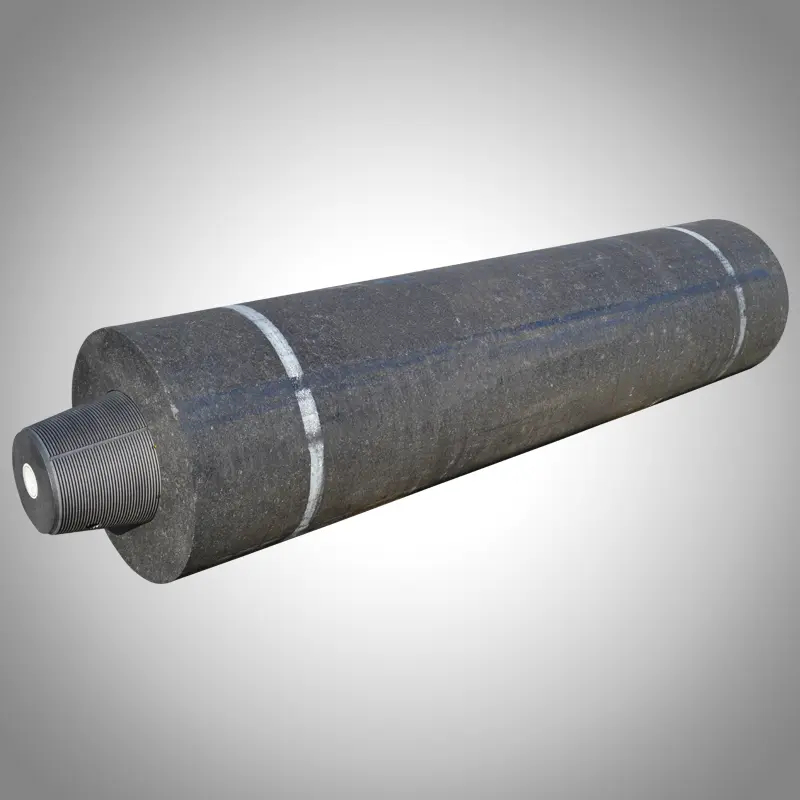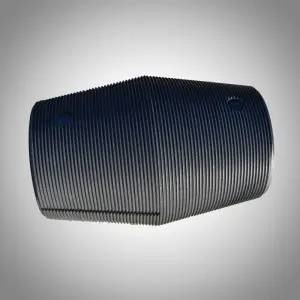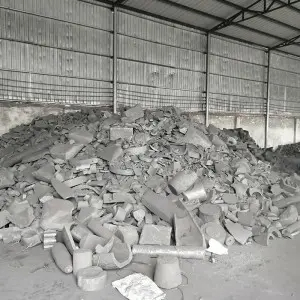In the world of metallurgy and electrochemistry, the choice of electrode material is not just a technical detail—it's a critical decision that impacts efficiency, cost, and the final quality of the product. From the intense heat of an electric arc furnace to the reactive environment of an electrolysis cell, the electrode is the heart of the operation. For decades, one material has consistently proven its superiority: graphite. This article explores the fundamental reasons why graphite is the preferred choice for electrodes across a wide range of demanding industrial applications, offering insights for professionals who rely on performance and reliability.
As Frank Liu, with over 30 years of experience at Hebei Heyuan New Material Technology Co., Ltd., I've seen firsthand how the right graphite electrode can transform a production line. This guide is for discerning professionals like Peter Kovac, a procurement director in Germany who understands that electrode quality is directly tied to operational stability and profitability. We will delve into the science behind graphite's unique properties, from its atomic structure to its real-world performance, providing a clear, comprehensive understanding of why this form of carbon is indispensable.
What Makes Graphite an Exceptional Electrode Material?
At its core, a good electrode must satisfy a demanding set of criteria. It needs to conduct electricity with minimal resistance, endure extreme temperatures without melting or deforming, resist chemical corrosion from reactants, and be strong enough to handle the mechanical stresses of an industrial environment. Furthermore, it must be economically viable. Graphite, a unique allotrope of carbon, checks all these boxes, making it an almost perfect electrode material.
The combination of high electrical conductivity, incredible thermal stability, and chemical inertness is rare. Most materials that conduct electricity well (like copper or silver) have relatively low melting points. Conversely, many materials that can withstand high temperatures (like ceramics) are poor electrical conductors. Graphite bridges this gap. Its properties aren't just adequate; they are exceptional, allowing it to perform reliably in environments where other materials would fail in moments. This is the primary reason for using graphite as an electrode.
Why is the Unique Structure of Graphite So Important for Conductivity?
To understand graphite's excellence, we must look at its atomic level. The structure of graphite consists of layers of carbon atoms arranged in a hexagonal lattice, much like a honeycomb. Within each layer, every carbon atom is bonded to three others. This leaves one "delocalized" electron per atom that is not locked into a bond. These free electrons can move easily along the layers, making graphite an excellent good conductor of electricity. Think of it as a superhighway for electrons, allowing an electric current to flow with very little resistance.
This layered structure is also what gives graphite its characteristic softness and lubricating properties. However, for a graphite electrode, these layers are bonded together during a high-temperature manufacturing process to create a solid, robust block. This process ensures that the high conductivity is maintained while also providing the high mechanical strength needed for industrial use. The resulting material is a powerful conductor that can carry the immense currents required in applications like arc furnaces. The ability to conduct electricity efficiently is the first and most critical reason graphite is used as an electrode.

How Does Graphite Withstand Extreme Temperatures in an Electric Arc Furnace?
One of the most dramatic applications of graphite is in an electric arc furnace (EAF) for steel recycling. Inside an EAF, temperatures can soar above 3,000°C (5,400°F)—hot enough to melt steel scrap in minutes. The graphite electrodes used in these furnaces are responsible for carrying the massive electrical current that creates the melting electric arc. Any lesser material would simply vaporize.
Graphite shines in this environment due to its incredibly high melting point of around 3,650°C (6,600°F). It doesn't melt under normal pressure but sublimates directly from a solid to a gas. This thermal resilience ensures the electrode maintains its structural integrity. Furthermore, graphite has a low coefficient of thermal expansion, meaning it doesn't expand or contract significantly with temperature changes. This property gives it excellent thermal shock resistance, preventing the electrode from cracking or shattering when rapidly heated. For steelmakers, this means less breakage, fewer production stoppages, and a more efficient melting process.
"In my 30 years in this business, I've seen that consistent performance under high temperature is what separates a quality electrode from a liability. A broken electrode can halt production for hours and cost a steel mill tens of thousands of dollars. That's why we focus so heavily on the quality of our petroleum coke and needle coke raw materials." - Frank Liu
Is Graphite Chemically Inert During the Electrolysis Process?
In electrochemical processes like electrolysis, the two electrodes are submerged in a chemical solution or molten salt called an electrolyte. This environment can be highly corrosive. For instance, in the electrolysis of brine (saltwater) to produce chlorine gas, the anode (the positive electrode) is exposed to highly reactive chlorine ions. A metal electrode would quickly corrode and contaminate the product.
This is where graphite's chemical inertness becomes a major advantage. Graphite is a non-metal and is highly resistant to attack by acids, bases, and other corrosive agents, especially at the anode where oxidation occurs. It does not react with the electrolyte or the products being formed, ensuring the purity of the final substance. While the graphite anode can slowly be consumed by reacting with oxygen in some high-temperature electrolysis processes (like aluminum production), its rate of consumption is predictable and far slower than that of alternative materials. This inertness is a key reason why graphite is widely used as an electrode in electrolysis.
What are the Key Industrial Applications of Graphite Electrodes?
The unique blend of properties possessed by graphite has led to its adoption in a multitude of critical industries. Its versatility makes it suitable for far more than just one task. Graphite electrodes are used across a spectrum of electrochemical and electrothermal applications.
Here are some of the primary uses:
- Steelmaking: In Electric Arc Furnaces (EAFs), massive graphite electrodes (sometimes more than two feet in diameter) are used to melt steel scrap. The EAF method is a cornerstone of modern recycling and accounts for a significant portion of global steel production.
- Aluminum Production: In the Hall-Héroult process, graphite is used as the anode to produce aluminum from alumina dissolved in molten cryolite. The carbon anode is consumed in the process, reacting with oxygen to form CO2.
- Electro-synthesis: In the chemical industry, graphite electrodes are frequently used to synthesize various compounds, including chlorine, caustic soda, and sodium metal through different electrolysis processes.
- Silicon Metal Production: Similar to EAFs, large furnaces use a carbon electrode (often a composite Söderberg electrode or pre-baked graphite) to produce silicon metal and ferroalloys.
- Batteries: While not a large-scale industrial process in the same vein, graphite is a critical anode material in most modern lithium-ion batteries, showcasing its versatility from massive furnaces to pocket-sized devices.
- EDM (Electrical Discharge Machining): Graphite is a common electrode material used to machine hard metals with high precision.

What’s the Difference Between RP, HP, and UHP Graphite Electrodes?
Not all graphite electrodes are created equal. The manufacturing process can be tailored to produce different grades with specific properties designed for different applications. At Heyuan Carbon, we specialize in the full range. Understanding these grades is vital for procurement managers like Peter, who need to match the electrode to the furnace's power requirements.
| Grade | Full Name | Raw Material | Key Characteristics | Typical Application |
|---|---|---|---|---|
| RP | Regular Power | Standard Petroleum Coke | Lower current density, higher resistivity | Low-power ladle furnaces, silicon metal |
| HP | High Power | High-quality Petroleum Coke | Higher current density, good thermal resistance | High-power EAFs, ladle refining furnaces |
| UHP | Ultra-High Power | Premium Needle Coke | Very high current density, low resistivity, excellent thermal shock resistance | Ultra-high power EAFs for steelmaking |
For a demanding application like Peter's steel mill, a UHP Graphite Electrode is essential. Using a lower-grade electrode in a UHP furnace would lead to rapid consumption and a high risk of breakage, causing costly downtime. The superior performance of UHP electrodes, derived from premium needle coke, justifies their cost through lower consumption rates (kg of electrode per ton of steel) and enhanced operational reliability. These electrodes must also be connected with equally high-quality Graphite Electrode Nipples to ensure a secure and highly conductive joint.
Why is a Graphite Anode Specifically Used in Many Electrolysis Setups?
In any electrolysis cell, you have two electrodes: the cathode (negative) and the anode (positive). The anode is often where the harshest chemical reactions occur. It is the site of oxidation, a process that can aggressively degrade the electrode material. For example, when electrolyzing a solution containing chloride ions (Cl-), these ions are drawn to the anode, give up their electrons, and form highly reactive chlorine gas (Cl2).
Using graphite as an electrode for the anode is ideal in these situations. First, as mentioned, it is chemically inert and can withstand the corrosive environment. Second, it is not a metal, so it doesn't release metallic ions that could contaminate the electrolyte and the desired product. While a platinum electrode could also be used and is even more inert, graphite is economical and offers excellent performance for a fraction of the cost, making it the only viable choice for large-scale industrial production. Its stability and cost-effectiveness make it the default anode material for many critical electrolysis processes.

How Do Graphite Electrodes Compare to Other Metal Electrodes?
While graphite is the dominant choice, other materials can be used for electrodes. Platinum, copper, and other metals are sometimes used in laboratory settings or for very specific niche applications. However, in large-scale industry, they fall short when compared to graphite for several reasons.
- Cost: Platinum is exceptionally stable but prohibitively expensive for industrial-scale use. Graphite products offer a far more cost-effective solution without a significant compromise in performance for most applications.
- Melting Point: Common metal electrodes like copper have a much lower melting point (1085°C for copper). They are completely unsuitable for the high-temperature environments of arc furnaces where graphite thrives.
- Reactivity: While some metals are unreactive, many (like copper) will react with the electrolyte, leading to contamination. Graphite's inertness prevents this, ensuring product purity.
- Weight: Graphite has a much lower density than most metals, making large electrodes easier to handle and imposing less mechanical stress on the furnace structure.
Ultimately, no other material offers the same balanced portfolio of high electrical conductivity, extreme thermal stability, chemical inertness, and affordability as a synthetic graphite electrode.
What Goes into Manufacturing a High-Quality Graphite Electrode?
The performance of a graphite electrode is a direct result of the quality of its raw materials and the precision of its manufacturing process. It's a complex, multi-stage journey that turns simple carbonaceous materials into a high-performance industrial tool. As a manufacturer, this is where our expertise lies.
- Raw Materials Selection: The process starts with carefully selected raw materials. For UHP electrodes, this means premium needle coke, known for its crystalline structure that ensures low electrical resistance and thermal expansion. For other grades, high-quality petroleum coke is used. Coal tar pitch is used as a binder.
- Forming: These materials are mixed and then extruded or molded into the shape of the electrode—a "green" electrode.
- Baking: The green electrode is slowly heated in a furnace over several weeks to carbonize the pitch binder and drive out volatile compounds. This step is critical for developing the electrode's density and strength.
- Impregnation: To increase density and strength, the baked electrode is often impregnated with more pitch and then re-baked.
- Graphitization: This is the final and most energy-intensive step. The carbon electrode is heated in a special furnace to temperatures approaching 3,000°C. This extreme heat forces the carbon atoms to rearrange into the ordered, layered crystalline structure of graphite, giving the final product its signature high conductivity and thermal stability.
- Machining: Finally, the graphite columns are precision-machined to create perfectly smooth surfaces and threaded sockets for connecting the electrode nipples. We also leverage this capability to produce Graphite Special-Shaped Parts for various industrial needs.

How Can You Identify a Reliable Graphite Electrode Supplier?
For a procurement director like Peter, choosing a supplier is as important as choosing the right electrode grade. The supplier relationship is a partnership built on trust, quality, and reliability. Inconsistent electrode quality can lead directly to his biggest pain points: operational shutdowns and unpredictable costs. So, what should you look for?
- Proven Experience and Expertise: Look for a manufacturer, not just a trader. A company with decades of production experience, like Hebei Heyuan, has a deep, practical understanding of how to control the manufacturing process to ensure consistent quality. We understand the metallurgy behind your operations.
- Quality Control and Certifications: A reliable supplier must have stringent quality control at every stage, from raw material inspection to final machining. Ask for technical data sheets and certifications like ISO 9001. A good supplier can provide detailed specifications for electrical resistivity, bulk density, flexural strength, and thermal expansion.
- Technical Support: Your supplier's sales team should be able to do more than just take an order. They should be able to discuss technical specifications and help you optimize electrode performance. This bridges the gap that often frustrates technically-minded buyers who face communication difficulties with less knowledgeable staff.
- Production Capacity and Logistics: A dependable supplier has the capacity to meet your demand and a proven track record of managing global logistics. They understand how to properly package and handle large, fragile graphite electrodes to prevent damage during transit, ensuring your production schedule is never disrupted by a delayed or damaged shipment. Our location in Handan City, a major hub for graphite production, gives us a strategic advantage in sourcing and logistics.
- Transparency and Long-Term Partnership: A good supplier is transparent about their processes and seeks to build a long-term relationship. They understand that their success is tied to your success.
Choosing the right partner ensures you receive not just a product, but a reliable, high-performance solution that minimizes your operational costs and eliminates the pain points of inconsistent quality.
Key Takeaways
To summarize, graphite's position as the leading material for industrial electrodes is no accident. It is a direct result of a unique combination of physical and chemical properties that are unmatched by other materials.
- Exceptional Electrical Conductivity: Its layered atomic structure contains delocalized electrons, allowing it to carry massive currents with minimal resistance.
- Unmatched Thermal Stability: With a sublimation point over 3,600°C and excellent thermal shock resistance, it can withstand the extreme temperatures of arc furnaces.
- Chemical Inertness: It resists corrosion from aggressive chemicals in electrolysis cells, ensuring product purity and a long service life as an anode or cathode.
- Cost-Effectiveness: It provides superior performance at a fraction of the cost of other stable materials like platinum, making it viable for large-scale industry.
- Versatility: From making steel and aluminum to enabling modern batteries, the applications of graphite electrodes are vast and critical to the global economy.
Post time: 9 月-26-2025













